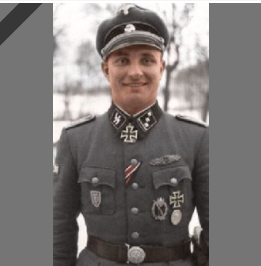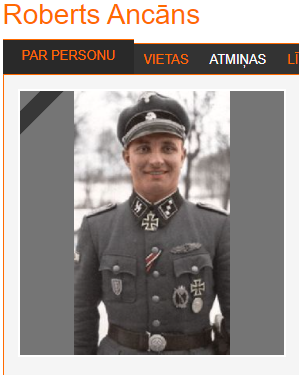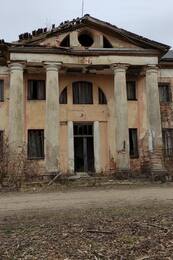The Battle of Pilsblīdene in the Memoirs of Roberts Ancāns
Robert Ancans (11 November 1919 - 1 January 1982) was an officer of the Latvian Legion, Knight's Cross of the Iron Cross, who took part in the battles of Pilsblidene on 16 and 17 March 1945. The Sixth Kurland Battle is now in its fourth day. Anzāns had served in the Pilsblidene area and therefore knew the area well. Anzans' division is again diverted by another break in the front - an 8km deep invasion by the Red Army. Anzán is wounded in these battles.
"On the night of March 16-17, my unit in Lestene was replaced by the Germans. We are on the road again. Our division is performing the role of "firefighters". It is raining. By the time daylight comes, we are in Jaunpils. Immediately the Bolsheviks also start air raids, we can only continue our journey after a good hour. The rain is easing and gradually turning into snow. The men are walking behind the carts, frozen, but there is no longer so much to fear from Russian air raids. So we continue our journey to Lake Zebre.
At Lake Zebre and in the Saldus region, cannons are continuously booming. The Sixth Battle of Courland continues for the fourth day. In the evening we reach the N. manor, where we hastily set up camp. By morning we must replace the defeated German units.
But morning has yet to come when the cars arrive and we have to drive to Pilsblīdeni, where there is an 8 km deep invasion. It has cleared, the moon is shining and it is starting to freeze. At first the car stops often because we get stuck in the mud and the wheels are covered in a thick layer of Courland clay. Soon, however, the frost melts the mud, and we get out at the Skrunda house. The men have not slept for two nights, are hungry and now everyone falls asleep like a dead man.
Together with the regiment commander, we go to the German division headquarters to receive battle orders. We are immediately accepted and are surprised, Gen. Schulz addresses us in Latvian, because he has served in the Latvian army and commanded an artillery regiment. Our task is to capture the Pilsblīdene castle and the highlands towards Saldus. The situation on the front is unclear.
We go to the regiment's new command post - Kuiļi mājas and, leaning over the table, we study the direction of the attack. I am a good connoisseur of the terrain here, because in 1940, when the 1st Liepāja Infantry Regiment was deployed to Courland, I served right at Pilsblīdene Castle and have participated in many combat training sessions in its vicinity.
The artillery barrage was supposed to start, but nothing. I called the regiment commander. He promised that it would, but the German artillery was no longer functioning properly. The attack was postponed for an hour. The men were exhausted. It was difficult to even change posts. The Bolshevik artillery and grenade launchers began to fire above us. Finally, at 5 p.m., our guns also began to fire a little and at 5:30 p.m. we went on the attack. The Bolsheviks had been waiting for our attack for several hours. We quickly suppressed the advanced advance groups and reached the castle, but we couldn't get any further, because at one point the Bolshevik automatic weapons barrage began on us, which was so strong that we couldn't even lift our heads. They were shooting not only from all corners of the houses, but also from windows and attics. There was a strong roar of tanks in the castle courtyard and in the surrounding area.
Several of them were involved in the battle, but our tanks did not get into the park. The enemy tank was out of reach of the tank fists. It would be foolish to continue the attack, why should we try to attack from the left, bypassing the pond.
This maneuver also fails, and the company has to retreat with losses through the burnt-out park.
After the unsuccessful attack, the Bolsheviks begin to take the initiative and attack our company on the high ground from both flanks. one from the castle and one along the Kaulači road from the forest. With the onset of darkness, we are forced to withdraw the company and move to defense along the edge of the railway line. Fatigue is insurmountable. The third sleepless night begins. With great difficulty, we manage to organize the changes of posts.
Suddenly, there is a great deal of enemy activity in and behind the palace. Commands, shouts, searchlights, the roar of engines. The sentry has been watching this for at least half an hour. After a while, the Bolsheviks really do begin a night attack, with strong tank support, as the whole air vibrates. We all rush out of the station into positions on the railway embankment. It is a little after one o'clock. Rockets are falling in parachutes as they slowly glide. Five Tigers deploy for battle. My funkists report the situation to the commander, but they fail to call in the artillery. Finally, something unusual happens.
Our transmitter has managed to catch the same wave as the Bolsheviks, and now we begin to play the role of Russian tank major Arturov.
With the help of this Artūrov, we diverted the incoming attack to where a small lake lay with a layer of loose ice on this side of the railway track. A Bolshevik tank was in flames, firing machine guns in continuous rounds, grenades were exploding.
As suddenly as it began, the fighting ended. The men are going to peace, it won't last long. The Russians want to pay back for the deception.
The light begins to fade, and now we notice that the Bolsheviks are attacking with an entire tank battalion and several infantry companies. We also manage to call in our artillery and, knowing the area well, I want to try my luck in the Tigers. Everything has already been agreed with the tank officer.
Our intention is to take a silent position with 3 tanks under cover on the left, let the Bolsheviks reach the railway line, and then destroy them with flanking fire.
It's already air, and the battle is now in full swing. The station is the target of all the enemy's heavy and automatic weapons. We have just explored the area with the tank lieutenant, when a grenade hits the tank and the fragments abundantly gather in my right hand and
in the leg.
The attack has been stopped, but my strength is running out.
I urgently ask the station's defenders for reinforcements of at least 10 tanks, but before they arrive, the station falls into their hands in the third Russian attack in the afternoon.
The ambulance slowly takes me to the rear. On the way I meet new units and tanks, which gives me faith that everything will be fine again.
Sitting next to the driver, I notice in the mirror how tired, bearded, sooty, bloodstained, and pale I look.
At 10:00 I am in Vāne, but the next day new wounded arrive and I am transferred to Stendi and then to Talsi. There the wounds are slowly being stitched up and out of the 13 holes in my arm, only 7 are open.
Easter is approaching and the new school in Talsi, which is now a military hospital, has many visitors and delegations. Our soldiers have no fewer gifts than they used to have in Riga, Kurzeme believes in its fighters.."
Roberts Ancāns (timenote.info)
Related timeline
Related objects
Pilsblidene Manor
The manor house was built in the classical style in the 1920s of the 19th century. After the land reform, the manor complex was rented out to private individuals, but from 1932 it passed to the Ministry of People's Welfare.
6. During the fierce battles of the Great Battle of Courland it was used both as a support post and as an infirmary.
On 17 March 1945, the last attempt of the Red Army to attack Courland began. Units of the German 24th Infantry Division defended themselves in the vicinity of the Pilsblidene Manor complex. On 18 March 1945, the manor house was attacked from the south by the 121st Rifle Regiment of the Latvian Rifle Division of the 43rd Guards, which was unsuccessful. The 1st Battalion of the 300th Rifle Regiment of the 7th Estonian Rifle Division attacked from the west, and at the end of the day the 35th Tank Brigade of the 3rd Guards Mechanised Corps joined the 1st Battalion of the 917th Rifle Regiment of the 249th Estonian Rifle Division on the Blīdene-Remte road.
On the night of 19 March, the 43rd Grenadier Regiment of the 19th Latvian SS Grenadier Division arrived in the vicinity of Blīdene Station and counter-attacked to retake the Pilsblīdene Manor residential building. However, as a result of a night tank attack, Estonian and Latvian units of the Red Army gained a foothold at the station.
In 1959, a fire broke out in the castle. From 1961 to 1986, a retirement home operated in the residential building. In 1986, the castle was again destroyed by fire. Since then, the castle has stood empty and ruined.
A 24-hectare park surrounds the manor house, which is now overgrown. The park has about 37 plantations of non-native species of trees and shrubs and is under state protection. The park is unmaintained and the surroundings are overgrown.







